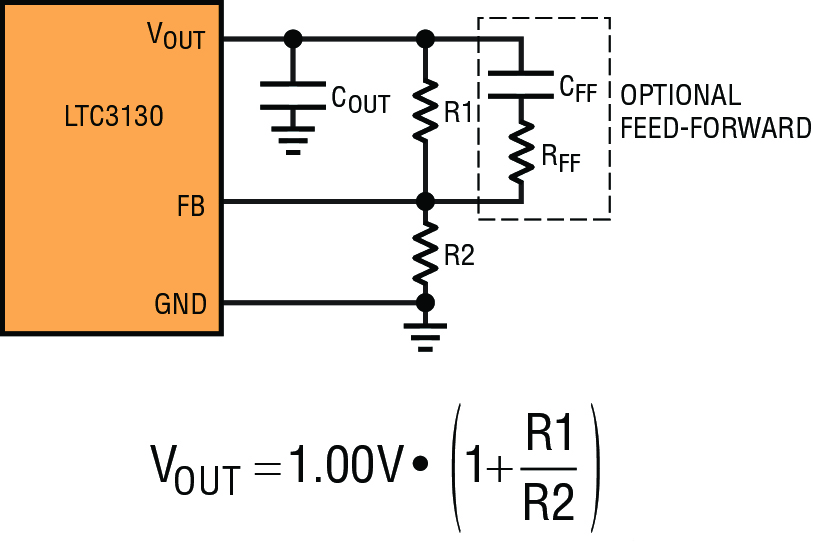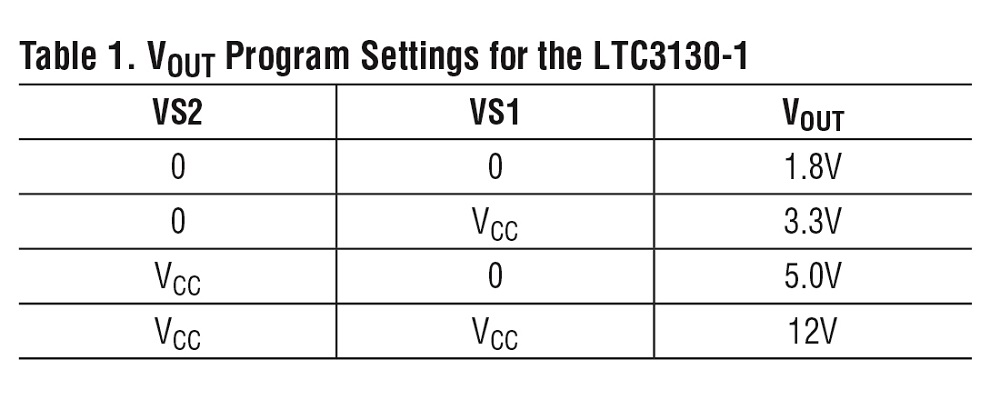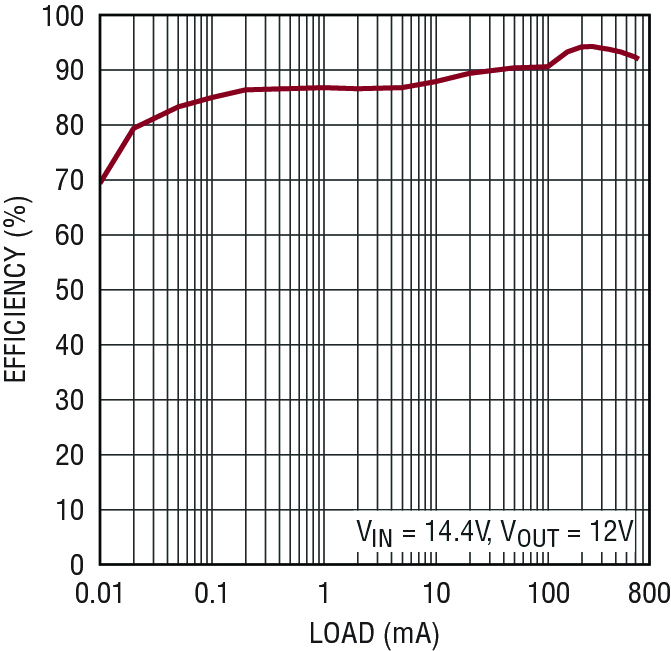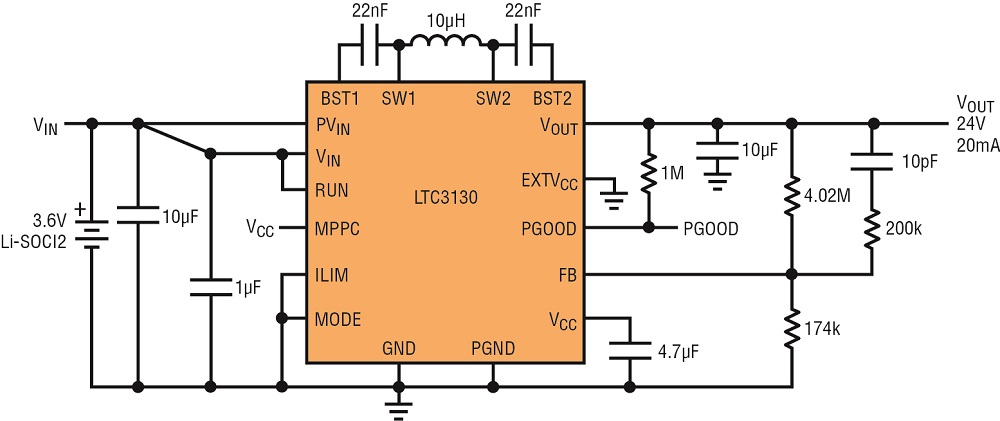BY DAVID LOCONTO, Design Center Manager — Power by Linear Products, and STEVE KNOTH, Senior Product Marketing Engineer — Power by Linear Products
Analog Devices, Inc.
www.analog.com
A buck-boost DC/DC converter is one of the most valuable tools in a power supply designer’s toolbox for dealing with a variety of power conversion scenarios. In these situations, input voltages can vary widely due to non-ideal or multi-input power sources, transient disturbances, or charging and discharging storage elements. Single-inductor, non-inverting buck-boost converters seamlessly step-down (buck) or step-up (boost) an input voltage and regulate the output voltage, regardless of whether the input is above, equal to, or below the output. The buck-boost converter’s three-way flexibility can replace two ICs (a separate buck converter or a low-dropout linear regulator plus a boost converter), thus saving space/footprint on the printed circuit board (PCB) and simplifying the bill of materials (BOM).
These converters greatly enhance battery life in portable systems as they take advantage of more of the battery’s useful input voltage range while regulating the output. In the case of multiple potential power sources, a buck-boost converter can be used in exclusively buck or boost mode depending on the power source. Furthermore, in a power backup application in which a discharging storage element has a discharge voltage curve that spans the required fixed output, a buck-boost converter will exercise both modes of operation.
Application conditions vary by market segment
Other than consumer products, input and output voltage ranges can vary widely depending on the application. For instance, in automotive environments, the 12-V car battery is the main supply for all electronics. However, that nominal 12 V can dip to as low as 3 V during cold cranking or spike up to near 40 V (limited by a transorb) during a load dump condition.
In industrial applications, standard power bus voltages are either 24 V or 12 V; in addition, higher-voltage power supply spikes, with durations ranging from a few microseconds to hundreds of milliseconds, are commonly encountered. The electronics in these systems must not only survive transient voltage spikes but, in many cases, also operate reliably throughout the event. Industrial and military/aerospace systems require wide operating temperature ranges and robust power delivery to essential downstream electronics even under stringent input voltage conditions (just like the automotive environment).
Furthermore, avionics, military, and aerospace environments have standard power rails but can also operate from various battery configurations and solar panels, thus requiring power supplies that can handle a very wide input voltage range. Some applications need to accept many different input sources so that any energy source will automatically power the system. Many military applications, for example, must accept different types of batteries, adapters, and even solar panels to provide their power.
Because these systems require multiple well-regulated power rails, the lower-voltage rails are typically supplied by buck regulators or low-dropout regulators (LDOs). There are requirements, however, for stabilized medium-to-high-level 12-V and 24-V rails for powering sensors and various analog functions (op amps, motors, or transceivers). Many of these require both buck and boost conversion depending on the power bus voltage level or the system configuration. A buck-boost converter (in some cases, with solar capability) provides the flexibility to regulate the output from a variety of input sources, minimizing the number of power converters in the design and thus simplifying the BOM.
Power conversion design challenges
In the past, designs requiring both buck- and boost-mode operation have been solved by using multiple power converters with their typical issues of PCB area, size, higher cost, greater complexity, lower reliability, higher quiescent current (IQ ), and lower conversion efficiencies. An alternative topology such as a single-ended primary inductance converter (SEPIC), while simpler than multiple power converters, has about a 10% lower efficiency than a synchronous buck-boost converter and requires two inductors and a high-current coupling capacitor, adding complexity and potential noise as well as reduced battery life.
Boost-mode operation in a buck-boost converter presents its own set of unique challenges, particularly when the boost converter is turned off or during initial application of the power source. The conventional boost converter has a direct path for current from VIN to VOUT through the inductor and the boost diode. This aspect of the boost converter can cause a large and potentially damaging inrush current when power is applied to VIN and thus keeps VOUT partially powered, with a diode drop below VIN when the power converter is shut down.
However, many of Analog Devices’ buck-boost converters provide an output disconnect feature that is inherent in its four-switch architecture. Thus, on initial application of power to VIN , the buck-boost converter’s input current is kept under control, gradually ramping from zero up to the current limit level while VOUT powers up. When turned off, the buck-boost converter completely disconnects VOUT from VIN so that VOUT can safely discharge all the way to zero.
Newer but maturing lithium-iron-phosphate battery chemistries enable longer run times, but their voltage discharge profiles are extended, with significant energy available at battery voltages below 3 V. This characteristic influences the related power conversion system, making synchronous buck-boost regulators necessary to generate outputs of 3 V or above, common in many systems including industrial.
Some backup applications that use supercapacitors are better served with buck-boost converters that can run down to very low input voltages. For example, a bank of capacitors (supercapacitors, electrolytics, etc.) gets charged to some voltage level. Should the power fail, the downstream buck-boost converter can maintain output regulation because it has the benefit of allowing the use of all of the energy in the capacitors. This can reduce the amount of capacitance needed in the application (reducing the capacitance and board area).
However, a more modern converter still needs 2.x V of input voltage to operate. Users, therefore, need to play some tricks (backfeeding, etc.) if they want to pull power from an input that is less than 2.x V. Many DC/DC converters cannot do this.
A few products that solve many of these issues include Analog Devices’ buck-boost converters. For inputs requiring 40-V capability, the LTC3115-1/-2 and LTC3114-1 are well-suited. For input voltage up to 15 V, the LTC3111, LTC3112, and the ultra-low-quiescent-current LTC3129 are available. A near-term future LTC311x family product will extend input voltage capability to 18 V and support 5 A of output current in buck mode.
Nevertheless, there has been a gap in the industry that has not been addressed — a buck-boost DC/DC converter compatible with 12-V/24-V systems, which also has moderate output current up to 600 mA, low-voltage operation after start-up, and ultra-low quiescent current.
Key considerations for selecting a buck-boost converter
A buck-boost solution that solves the issues described above should have the following attributes:
- Operation over a wide input/output voltage range
- Sufficient output current capability
- Ultra-low IQ
- Low output noise/ripple
- High-efficiency operation
- Output disconnect when operating in boost mode
- Minimal external components required, easy to design
- Excellent thermal performance
A few examples that address these needs include Analog Devices’ LTC3130 and LTC3130-1. These 25-V input- and output-rated monolithic synchronous buck-boost converters can supply up to 600 mA of output current in buck mode and provide an extremely low 1.2-µA no-load quiescent current (see Fig. 1 ). Each device offers a 2.4-V to 25-V input voltage range and a 1-V to 25-V output range (LTC3130 is adjustable; see Fig. 2 ) and provides a regulated output with inputs above, below, or equal to the output. Once started, the devices have only a 0.6-V typical input voltage requirement. User-selectable Burst-Mode operation lowers quiescent current to only 1.2 µA, improving light-load efficiency and extending battery run time.

Fig. 1: LTC3130 typical application schematic and features.

Fig. 2: VOUT feedback divider equation and schematic for the LTC3130.
The LT3130 also offers EXTVCC capability. The device’s EXTVCC powers the IC if >3 V (range: 3 V to 25 V).
The proprietary buck-boost topology of the LTC3130/-1 provides low-noise, jitter-free switching through all operating modes, which is well-suited for RF and precision analog applications that are sensitive to power supply noise. The devices also include programmable maximum power point control (MPPC) capability, ensuring maximum power delivery from non-ideal power sources such as photovoltaic cells.
The LTC3130-1 shares all the features of the LTC3130 but offers four user-selectable fixed output voltages — 1.8 V, 3.3 V, 5 V, and 12 V — eliminating the resistor divider required for the adjustable output version (See Table 1 ).
Table 1: VOUT program settings for the LTC3130-1.

The LTC3130/-1 has sufficient voltage margin to handle 1 series to 6 series lithium battery input systems and nominal 12-V systems subject to large noise spikes as well as the ability to power 24-V sensors. A guaranteed minimum 660-mA inductor current limit provides boost-mode output current capability, particularly for 24-V sensors that must operate from low input voltages, such as 3.3-V or 5-V batteries.
The LTC3130/-1 includes four internal low RDSON N-channel MOSFETs to deliver efficiencies of up to 95%. Converter start-up can be achieved from sources capable of supplying as little as 7.5 µW, making the LTC3130/3130-1 well-suited for applications powered by weak sources, including thin-film solar cells. Alternatively, Burst-Mode operation can be disabled, offering low-noise continuous switching. The LTC3130/-1’s constant 1.2-MHz switching frequency ensures low noise and high efficiency while minimizing the size of the external components (see Fig. 3 ). Built-in loop compensation and soft-start reduce external parts count and simplify design.

Fig. 3: LTC3130/-1 efficiency is 94% for 14.4 VIN to 12 VOUT at 200 mA.
24-V sensor application
Fig. 4 highlights a battery-powered 24-V sensor power supply. Power for the sensor is provided by a high-reliability, long-life, lithium-thionyl-chloride primary battery. To maximize service life, the sensor is only activated for brief intervals with a long-time period between activations, reverting to a near-zero power state when inactive.

Fig. 4: Battery-powered 24-V converter with 200-mA ILIM to limit battery droop.
The 200-mA input current limit option of the LTC3130 is used (ILIM pin = GND) to minimize peak currents taken from the high-output-impedance lithium-thionyl-chloride battery when the sensor is activated, further prolonging the service life of the battery. The LTC3130 is shut down by driving its RUN pin low during long idle periods, drawing only 1 µA from the 24-V output.
The sensor is also disconnected from the 24-V rail or shut down to minimize discharge of the 24-V output capacitor during the long idle periods. With the 24-V output maintained in this fashion, the sensor can power up quickly, make the required measurement, and then power down again without having to wait for the 24-V power rail to charge. During normal operation of the sensor, this DC/DC converter achieves up to 83% efficiency.
Conclusion
The single-inductor, non-inverting buck-boost converter is an extremely flexible and valuable power supply component. Flexibility and features such as MPPC and EXTVCC enable a range of unique powering scenarios that are well suited to solve problems across a wide variety of applications.
Advertisement
Learn more about Analog Devices, Inc.





